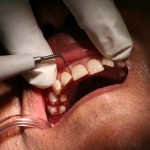
The scale and polish (S&P) or prophylaxis involves the removal of mineralised plaque deposits (calculus or tartar), debris and staining from the crown and root surfaces of the teeth together with mechanical removal of residual extrinsic stains and deposits using prophylaxis paste rubber cup or bristle brush by a dentist or a dental care professional (dental therapist or dental hygienist). The routine S&P does not include any other form of periodontal treatment.
This Cochrane review update aimed to determine the beneficial and harmful effects of routine scaling and polishing: –
- for periodontal health
- at different recall intervals for periodontal health
- when the treatment is provided by dentists compared with dental care professionals (dental therapists or dental hygienists).
Methods
Searches were conducted in the Cochrane Oral Health’s Trials Register, the Cochrane Central Register of Controlled Trials (CENTRAL) Medline, Embase, the US National Institutes of Health Ongoing Trials Register (ClinicalTrials.gov) and the World Health Organization International Clinical Trials Registry Platform with no restrictions on the language or date of publication.
Randomised controlled trials (RCTs) of routine scale and polish treatments, with or without oral hygiene instruction, in healthy dentate adults without severe periodontitis were considered. Split-mouth studies were excluded.
Study selection, data abstraction and risk of bias assessment was carried out independently by two review authors. Risk ratios (RR) were used for dichotomous data and mean differences (MD) or standardised mean difference (SMD) for continuous data, with 95% confidence intervals (CIs). A fixed effects model was used for meta-analysis. The certainty of the evidence was assessed using the GRADE approach.
Results
- 2 studies conducted in UK general dental practice were included (1711 patients analysed).
- Studies involved adults without severe periodontitis who were regular attenders at dental appointments.
- One study measured outcomes at 24 months and the other at 36 months.
- Neither study measured adverse effects, changes in attachment level, tooth loss or halitosis.
- No studies evaluated routine scaling and polishing (S&P) provided by dentists compared with dental care professionals (dental therapists or hygienists)
- 2 studies compared planned, regular interval (6- & 12-monthly) S&P treatments versus no scheduled treatment.
- There was little or no difference between groups over a two- to three-year period for gingivitis, probing depths, oral health-related quality of life (all high-certainty evidence) and plaque (low-certainty evidence).
- Regular planned S&P treatments produced a small reduction in calculus levels over two to three years when compared with no scheduled S&P treatments (high-certainty evidence).
- Patients’ self-reported levels of oral cleanliness were higher when receiving six- and 12-monthly S&P treatments compared to no scheduled treatment, but the certainty of the evidence is low.
| Gingivitis SMD (95%CI) | Calculus levels SMD (95%CI) | |
| 6/12 S&P v no scheduled treatment | 0.01 (-0.13 to 0.11) | -0.32 (-0.44 to -0.20) |
| 12/12 S&P v no scheduled treatment | -0.04 (-0.16 to 0.08) | -0.19 (-0.31 to -0.07) |
| 6/12 v 12/12 S&P | 0.03 (-0.09 to 0.15) | -0.13 (-0.25 to -0.01) |
- Two studies compared routine 6-monthly S&P treatments versus 12-monthly treatments. We found little or no difference between groups over two to three years for the outcomes of gingivitis, probing depths, oral health-related quality of life (all high- certainty evidence) and plaque (low-certainty evidence).
- Six- monthly S&P treatments produced a small reduction in calculus levels over a two- to three-year period when compared with 12-monthly treatments. The clinical importance of this small reduction is unclear.
- The comparative effects of 6- and 12-monthly S&P treatments on patients’ self-reported levels of oral cleanliness were uncertain (very low-certainty evidence).
- The review findings in relation to costs were uncertain (very low-certainty evidence).
Conclusions
The authors concluded: –
For adults without severe periodontitis who regularly access routine dental care, routine scale and polish treatment makes little or no difference to gingivitis, probing depths and oral health-related quality of life over two to three years follow-up when compared with no scheduled scale and polish treatments (high-certainty evidence). There may also be little or no difference in plaque levels over two years (low-certainty evidence). Routine scaling and polishing reduces calculus levels compared with no routine scaling and polishing, with six-monthly treatments reducing calculus more than 12-monthly treatments over two to three years follow-up (high-certainty evidence), although the clinical importance of these small reductions is uncertain. Available evidence on the costs of the treatments is uncertain. The studies did not assess adverse effects.
Comments
This Cochrane review update includes the findings from the recently published IQuaD study which we looked at last year (Dental Elf – 16th Jul 2018). The findings from the two well conducted primary care studies included in this review demonstrate little or no clinical benefit from 6 monthly S&P in adults without severe periodontal disease who attend for regular dental care. The UK NHS currently funds 6 monthly S&P for patients so the implications for lack of clinical benefit for some adults needs to be taken into consideration.
Links
Primary Paper
Lamont T, Worthington HV, Clarkson JE, Beirne PV. Routine scale and polish for periodontal health in adults. Cochrane Database of Systematic Reviews 2018, Issue 12. Art. No.: CD004625. DOI: 10.1002/14651858.CD004625.pub5.
Other references
Cochrane Oral Health Group Blog – Routine scale and polish has little or no effect on gingivitis
Dental Elf – 16th Jul 2018
Periodontal health: no additional benefit from 6 monthly Scale and Polish
Dental Elf – Scale & Polish Blogs
